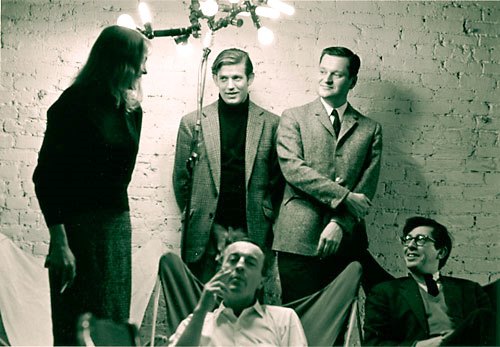Frank O’Hara’s East Village
This post is adapted and updated from an earlier Off the Grid post written by Karen Loew in 2014.

On June 10, 2014, GVSHP and Two Boots Foundation had the great pleasure of marking, with a commemorative plaque, the home of poet Frank O’Hara at 441 East 9th Street (just west of Avenue A). In honor of that upcoming anniversary, we’re looking back on the vibrant, inquisitive life of Frank O’Hara and his connection to the East Village neighborhood.
—
I am mainly preoccupied with the world as I experience it, and at times when I would rather be dead the thought that I could never write another poem has so far stopped me. … What is happening to me, allowing for lies and exaggerations which I try to avoid, goes into my poems. I don’t think my experiences are clarified or made beautiful for myself or anyone else; they are just there in whatever form I can find them.
— Statement for “The New American Poetry,” 1959
Frank O’Hara’s poems are many things to many people, but most of all they are astonishingly fresh and intimate today, nearly half a century after the poet’s untimely death at the age of forty.
New York City was where O’Hara — born in Baltimore in 1926 and killed in a car accident on Fire Island in 1966 — lived his entire adult life, and it served as his greatest muse. New York was the generative force for his other inspirations, from modern art, to friendships with artists, to urbane parties and conversations, to sybaritic pleasures, to living in relative freedom as a gay man at a repressive time.
He led a lively love life, and published a poem entitled Homosexuality in 1954 — not long after the American Psychiatric Association listed homosexuality as a sociopathic personality disturbance, and President Dwight Eisenhower signed an executive order banning homosexuals from working for the federal government or any of its private contractors. Yet O’Hara seemed to wear his sexuality with a radical lightness, writing poems that reveled in love and sex with the same joie de vivre that he used to write about movie stars, friends, art and artists, booze and cigarettes.

For his exuberance, and exuberant love of New York City, and love of men, he is often compared to Walt Whitman, born more than a century earlier, and blessed with a more timely death at the age of 72 (although Whitman was nowhere near as “out” as O’Hara, thus scholars disagree on the exact nature of his sexuality).
O’Hara’s several residences downtown included an apartment in the tenement at 441 East Ninth Street, just west of Tompkins Square Park. He lived there with his on-and-off lover, Joe LeSueur, who later published the memoir Digressions on Some Poems by Frank O’Hara and died in Easthampton in 2001.

As he states above, O’Hara indeed puts “what is happening to me” in his poems. From his window on East Ninth Street he could see the Church of St. Brigid (which he called St. Bridget’s) across Tompkins Square Park on Avenue B at East Eighth Street, and mentioned it in several poems. Here’s part of “Early on Sunday,” 1961:
…how sad the lower East Side is on Sunday morning in May
eating yellow eggs
eating St. Bridget’s benediction
washing the world down with rye and Coca-Cola and the news
Joe stumbles home
pots and pans crash to the floor
everyone’s happy again
“Poem” from 1957 begins:
I live above a dyke bar and I’m happy.
The police car is always near the door
in case they cry
or the key doesn’t work in the lock. …
In “Rhapsody,” 1959, in-between dropping names from Elizabeth Taylor to Jane (usually Jane Freilicher, the Village painter) and landmarks from the Empire State Building to the Menemsha Bar, there’s this bit of the local:
I am getting into a cab at 9th Street and 1st Avenue
and the Negro driver tells me about a $120 apartment
“where you can’t walk across the floor after 10 at night
not even to pee, cause it keeps them awake downstairs”
no, I don’t like that “well, I didn’t take it”
perfect in the hot humid morning on my way to work
a little supper-club conversation for the mill of the god
And since 2014, the plaque at East Ninth Street is a physical representation of these East Village musings in O’Hara’s poetry. In this way, O’Hara’s joyful, romantic spirit is brought more fully into the East Village, as other plaques in the neighborhood do for anarchist Emma Goldman on East Thirteenth Street, Argentine composer Astor Piazzolla on East Ninth Street, and radical saloonkeeper Justus Schwab on East First Street — the latter being the first plaque dedicated in the five-year-old program co-sponsored by GVSHP and Two Boots.
This year, we’ll continue to mark sites of vital importance in the East Village with a plaque at 27 Cooper Square – the dynamic home of many revolutionary East Side cultural pillars, including writers LeRoi and Hettie Jones’, musician Archie Shepp and painter Elizabeth Murray. Join us on June 20 for the unveiling ceremony, which will include words from Hettie Jones, still a resident in the building today.
